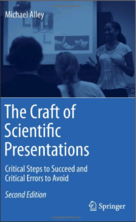This repository contains slide templates for Professor Michael Alley's famous assertion-evidence slide design. This effective communication style is described in the book The Craft of Scientific Presentations: Critical Steps to Succeed and Critical Errors to Avoid, by Michael Alley, Springer, 2nd edition, 2013.
How to use? Simply copy the slide template for the slide format you want to use, give the file a proper name, and fill in your own content!
The slide template contains styles for the
- title slide
- mapping slide
- standard assertion-evidence slide
- summary slide
The slide template comes in several formats:
- Microsoft PowerPoint: folder - download for local viewing
- LibreOffice/OpenOffice: folder - download for local viewing
- Apple Keynote: folder - download for local viewing
- Google Presenter: folder - download
- LaTeX Beamer: LaTeX source file - online viewing
- HTML5 reveal.js: HTML source file - online viewing
- HTML5 deck.js: HTML source file - online viewing
- Remark: Markdown source file - online viewing
- Plain HTML slides in solarized colors: HTML source file - online viewing
- DocOnce: DocOnce source file, translates to HTML, Beamer, Remark as above
- Either dowload zip file (see Download ZIP button to the right in this view), pack out the
master.zipfile, or - clone/fork this Git repository:
git clone git@github.com:hplgit/MAlley-slide-templates.git
- Binary slide files (PowerPoint, LibreOffice, Google Presenter): click download for local viewing and the file should download (if not, click on folder, then on the file, then on Raw, and if necessary, right-click to download the page), load the file into the software
- Keynote: click download for local viewing, pack out
master.zipfile, loadkeynote/AE_presentation_templateinto Keynote - Pure (ascii) text file slides (reveal.js, deck.js, LaTeX Beamer, HTML, Remark, DocOnce): click on source file, click on Raw, and download that file
Interactive slides tools offer a graphical user interface to design slides in a visual way - you click and drag until you are satisfied. This is user-friendly, and if slide elements are not perfectly postioned, it is easy to graphically move them the way you want.
The support in interactive tools for slides with much mathematics and computer code is modest. There are LaTeX-based equation editors for PowerPoint and LibreOffce, but they are tedious to use for large amounts of formulas. Another (and often better) solution is to convert each formula to an online picture using http://www.codecogs.com/latex/eqneditor.php. Here you can copy and paste existing formulas from LaTeX documents. Computer code is not well supported in interactive tools. Syntax highlighting is impossible and you are left with setting the code in monospace font manually. Consequently, slides with much mathemtics and computer code look much better in markup languages like LaTeX, HTML, Markdown, or DocOnce.
Tools for interactive slide design include Microsoft PowerPoint, Apple's Keynote, OpenLibre Impress, OpenOffice Impress, and Google Presenter (Google slides). The latter is very easy to use and has recently become very popular because of its features for online collaboration, though PowerPoint and Keynote are technically more advanced tools than Google Presenter.
[Google Presenter video](https://www.youtube.com/watch?v=RrpjzquqUIo] Google presentation tutorial)
Slides can alternatively be designed using a markup language, e.g.,
LaTeX, HTML, Markdown, or DocOnce.
Instead of clicking on an italic button
to get italic text in an interactive slide tool, one writes instead plain text <em>some text</em> in HTML,
\emph{some text} in LaTeX, or
*some text* in Markdown and DocOnce. The whole slide presentation is a plain
text file with instructions (markup) and slide contents.
A main problem with markup languges is that you have much less control of where slide elements appear on the slide compared with the interactive, visual tools. However, markup languages have some important advantages:
- excellent support for mathematics and computer code
- sometimes quicker writing (especially in Markdown and DocOnce)
- easy to generate slides from existing papers and books
- easy to change notation, terms, etc. in a large set of slides
For at least two decades, LaTeX Beamer has been a dominating tool for writing slides with mathematics and computer code. Recently, LaTeX Beamer has experienced considerable competition from reveal.js and to some extent deck.js. Both these tools are based on modern HTML5 and CSS technology and combine in some way the strength for mathematics and computer code from LaTeX Beamer with the visual appearance of PowerPoint, Keynote, OpenOffice/LibreOffice, and Google Presenter. Especially in more mathematically or computer science oriented communities, there is significant use of LaTeX Beamer and reveal.js, with the Markdown-based Remark tool as a new interesting alternative coming up (Markdown-based tools are gaining increasing popularity in general).
Remark about markup-based slides in this repository. The HTML, reveal.js, deck.js, Remark, and LaTeX Beamer slides in this repository were all automatically generated from slides in DocOnce format. So to write LaTeX Beamer slides, one can either write directly in LaTeX markup, or one can write in DocOnce markup and automatically translate to LaTeX Beamer. The advantage of writing in DocOnce is that one can easily generate reveal.js, deck.js, Remark, and plain HTML slides as well. That feature gives you the possibility to use Beamer for live presentations, but publish the talk online in (e.g.) reveal.js format.
The content of this repository was created by Hans Petter Langtangen (hplgit), Simula Research Laboratory and Unviersity of Oslo, Norway. Please send comments on typos or improvements in this description to him at hpl@simula.no. All templates are based on PowerPoint slides made by Professor Michael Alley.
Do you see better technical solutions in some slide set? Fork the project and send a pull request if you implement improvements! Or make an issue about a question or problem setting here on GitHub.

